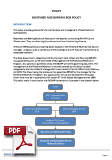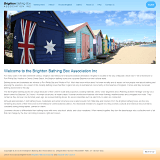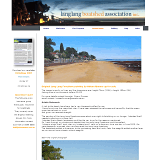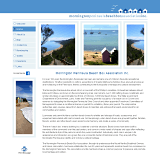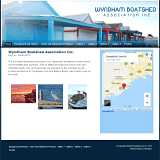About boatsheds, Kingston and the KBA
About boatsheds
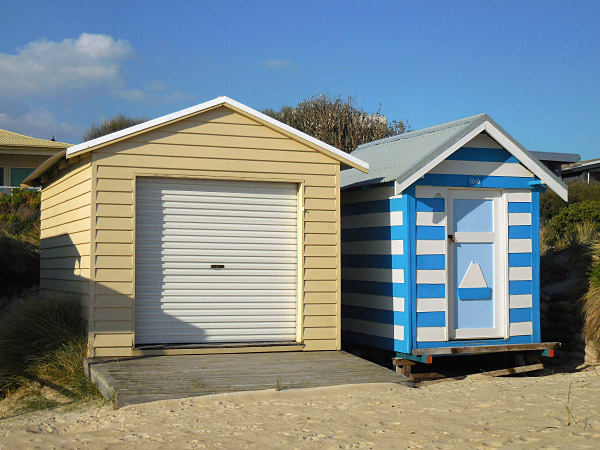
‘Boatsheds’ and ‘bathing boxes’ are an iconic feature of various beaches all around Port Phillip in Victoria, Australia. These colourful wooden buildings – typically built in groups just above the high-water mark – are designed to securely house belongings directly on beaches.
Their different sizes and shapes reflect their traditional function:
- Boatsheds are generally larger and are intended mainly to store a boat, hence they often have an integrated ramp (see photo) and winch.
- Bathing boxes are smaller and are intended mainly to provide a private space for changing into and out of bathing gear.
Intended use aside, either structure can be used for either purpose. The only real restriction is that people may not live in them.
Besides their visual appeal, boatsheds and bathing boxes have heritage significance, many having been built in the late 1800s and early 1900s (see history below). Maintaining the historic character of Victoria's boatsheds is an important part of ownership.
About Kingston's boatsheds
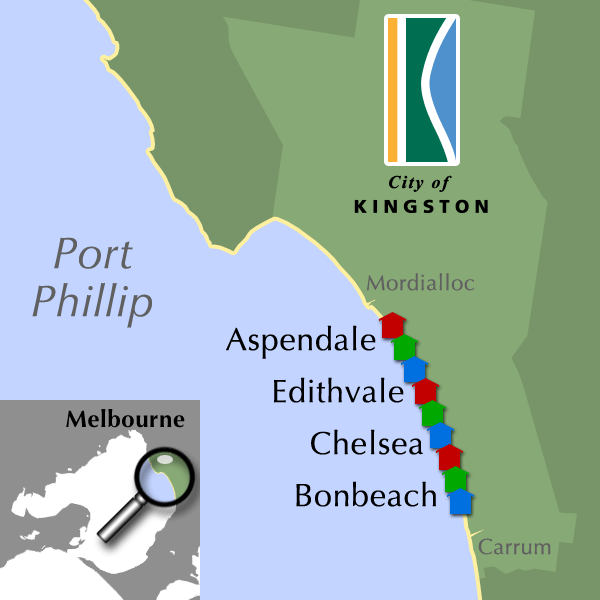
The City of Kingston lies on the eastern shores of Port Phillip, some 15km south-east of Melbourne. The City is home to 190 boatsheds and bathing boxes along a 6km long stretch of beach between Aspendale in central Kingston and Bonbeach in Kingston's south (see map).
- Aspendale – 29 sheds
- Edithvale – 86 sheds
- Chelsea – 56 sheds
- Bonbeach – 19 sheds
The two longest continuous stretches of sheds are the group of 15 near Bapaume Avenue, Edithvale and the group of 10 near Roycroft Avenue, Aspendale.
(See Photo Gallery: Group of 15, Group of 10).
Getting to Kingston's boatsheds
Kingston's boatsheds can usually be found within a short, easy walk from the side streets that run between Nepean Highway and the foreshore in the bayside suburbs of Aspendale, Edithvale, Chelsea and Bonbeach.
The following PDF lists of all of Kingston's boatshed locations and the nearest streets.
Download PDF:
kingston-boatshed-locations.pdf (0.1 Mb)
Kingston's boatshed history
Early settlement
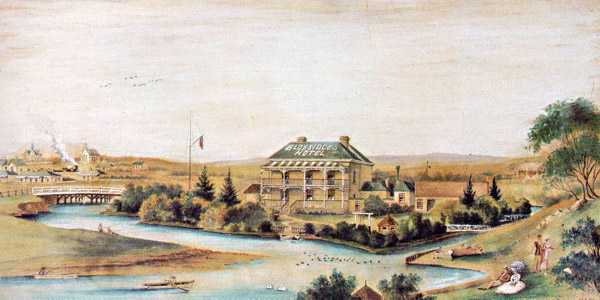
(Image: Kingston photo archive)
At the heart of Kingston's shores is the city of Mordialloc, first settled by Europeans in the early 1800s. Like the Aborigines before them, settlement centred around the mouth of the Mordialloc Creek. The creek and bay both contained plentiful fish, while the surrounding hinterland was suitable for livestock, subject to clearing.
By 1839 a squatter introduced cattle to the area and a small wooden hotel was built by 1853 on the site of successive Mordialloc hotels.1
Establishment of ‘Long Beach’

(Photo: The Australasian)
South of the Mordialloc Creek lies a 6km long unbroken stretch of shoreline known as ‘Long Beach’. This area was originally characterised by wide, sandy beaches, grassy dunes and abundant tea-tree, with the low-lying Carrum Carrum Swamp further inland.
‘Long Beach’ became better established following the opening of a road from Mordialloc Bridge to Frankston in 1863 and the draining of the swamp in 1879. The railway line from central Melbourne reached Mordialloc in 1881, with the section through to Frankston completed in 1882.
The new railway stations at Mordialloc and Carrum at last made ‘Long Beach’ easily accessible to weekenders and day trippers. The area's remoteness, sandy soil and tea-tree were a drawcard for summer campers, with the shallow gradient of the beach making for relatively safe paddling and bathing of children and adults alike.
Land sales of what was previously thought to be wasteland between the railway line and the foreshore saw the area gradually transformed into the bayside suburbs of Aspendale, Edithvale, Chelsea, Bonbeach and Carrum.2
Long Beach's first boatsheds and bathing boxes
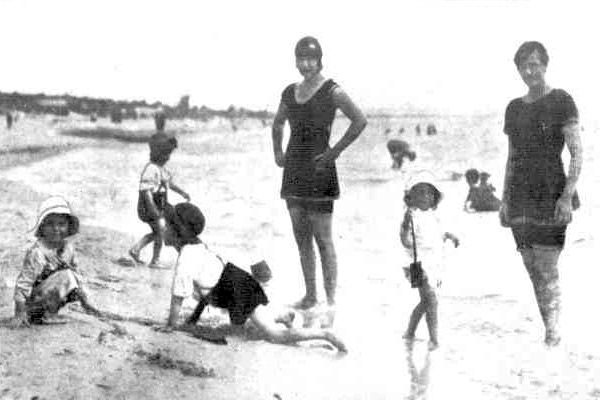
(Photo: The Australasian)
Boatsheds and bathing boxes first appeared on ‘Long Beach’ after the Shire of Moorabbin gave permission in 1883. These simple structures gave people the privacy and amenity formerly only available at public salt-water baths nearer Melbourne. They could now enjoy the safe, clean waters of Kingston's beaches while adhering to 19th century morals and sensitivities surrounding public bathing and attire.
Requests to build boatsheds and bathing boxes increased significantly in the early 1900s. The City of Chelsea imposed a residency and/or ratepayer requirement in 1934 for all foreshore licences issued within the City. Boatsheds and bathing boxes continued to be built after WWII until the mid 1960s.
Boatshed construction today
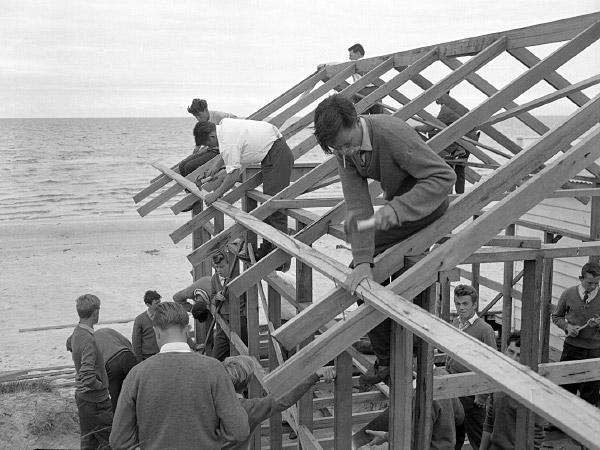
(Photo: Leader Collection, City of Kingston)
Since the late 1960s, new boatsheds and bathing boxes are no longer being built in Kingston. That said, their coastal location dictates that existing structures need regular maintenance and repairs to keep them in good order and appearance. It is a rare shed indeed that has survived 100+ years of sand, salt-spray and surf without having undergone a partial or near-complete rebuild.
Both the Victorian State Government and the City of Kingston have guidelines (see below) on the nature and scope of work that can be undertaken on existing sheds in order to maintain heritage character, minimise environmental impact and meet broader community expectations.
Boatshed reference materials
The following PDF gives an amazing amount of detail on all aspects of boatshed and bathing box construction. Contains invaluable info for anyone undertaking boatshed maintenance and repairs.
Download PDF:
Bathing box construction guidelines (PDF) (2.0 Mb)
The following PDF is Kingston Council's boatshed and bathing box policy. Essential reading for boatshed owners to understand their rights and responsibilities as licensees / permit holders.
Download PDF:
Boatshed and bathing box policy (PDF) (1.8 Mb)
The following PDF is Kingston Council's boatshed transfer permit form. Required when transferring ownership of a boatshed or bathing box.
Download PDF:
Boatshed transfer permit form (PDF) (0.03 Mb)
About the Kingston Boatshed Association

An important stakeholder representing nearly all foreshore licence holders is the Kingston Boatshed Association (KBA).
The Association was formed to respond to expressed summer grievances culminating in a Kingston City Council (Council) organised meeting on 27-Mar-2002, attended by invited speakers, licence holders and families.
The Association incorporated on 24-May-2002 with objectives that include preserving and promoting local heritage and culture, representing members and providing Council’s mandatory boatshed public liability insurance.
Kingston Council's ‘Boatshed and Bathing Box Policy’ – with change iterations and other matters – is jointly reviewed by Council and the Kingston Boatshed Association.
Legal details
Registered name:
Kingston Boatshed Association, Inc.
Registered address:
P.O. Box 422
Chelsea, Vic. 3196
Australia
Incorporation date:
24-May-2002
ARBN:
A0042630F
Other boatshed associations
Here's some links to websites of other similar boatshed and bathing box associations around Port Phillip.
Brighton Bathing Box Association:
http://www.brightonbathingbox.org.au/
Lang Lang Boatshed Association:
http://langlangboatsheds.org.au/
Mornington Peninsula Beach Box Association:
Wyndham Boatshed Association:
References
1McGuire, F., (1985), Mordialloc – the early years. A Brief history, p.10.
2Victorian Parliamentary Papers, (1915), ‘First Progress Report from the Royal Commission on the Housing Conditions of the People in the Metropolis’ in Grant, J. & Serle, G. (1978), The Melbourne Scene 1803-1956, pp. 241-242.



